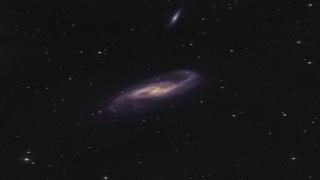Bibcode
Comerón, S.; Salo, H.; Laurikainen, E.; Knapen, J. H.; Buta, R. J.; Herrera-Endoqui, M.; Laine, J.; Holwerda, B. W.; Sheth, K.; Regan, M. W.; Hinz, J. L.; Muñoz-Mateos, J. C.; Gil de Paz, A.; Menéndez-Delmestre, K.; Seibert, M.; Mizusawa, T.; Kim, T.; Erroz-Ferrer, S.; Gadotti, D. A.; Athanassoula, E.; Bosma, A.; Ho, L. C.
Referencia bibliográfica
Astronomy and Astrophysics, Volume 562, id.A121, 160 pp.
Fecha de publicación:
2
2014
Revista
Número de citas
107
Número de citas referidas
102
Descripción
Context. Resonance rings and pseudorings (here collectively called
rings) are thought to be related to the gathering of material near
dynamical resonances caused by non-axisymmetries in galaxy discs. This
means that they are the result of secular evolution processes that
redistribute material and angular momentum in discs. Studying them may
give clues on the formation and growth of bars and other disc
non-axisymmetries. Aims: Our aims are to produce a catalogue and
an atlas of the rings detected in the Spitzer Survey of Stellar
Structure in Galaxies (S4G) and to conduct a statistical
study of the data in the catalogue. Methods: We traced the
contours of rings previously identified and fitted them with ellipses.
We found the orientation of bars by studying the galaxy ellipse fits
from the S4G pipeline 4. We used the galaxy orientation data
obtained by the S4G pipeline 4 to obtain intrinsic
ellipticities and orientations of rings and the bars. Results:
ARRAKIS contains data on 724 ringed galaxies in the S4G. The
frequency of resonance rings in the S4G is of 16 ± 1%
and 35 ± 1% for outer and inner features, respectively. Outer
rings are mostly found in Hubble stages - 1 ≤ T ≤ 4. Inner rings
are found in a broad distribution that covers the range - 1 ≤ T ≤
7. We confirm that outer rings have two preferred orientations, namely
parallel and perpendicular to the bar. We confirm a tendency for inner
rings to be oriented parallel to the bar, but we report the existence of
a significant fraction (maybe as large as 50%) of inner features that
have random orientations with respect to the bar. These misaligned inner
rings are mostly found in late-type galaxies (T ≥ 4). We find that
the fraction of barred galaxies hosting outer (inner) rings is ~1.7
times (~1.3 times) that in unbarred galaxies. Conclusions: We
confirm several results from previous surveys as well as predictions
from simulations of resonant rings and/or from manifold flux tube
theory. We report that a significant fraction of inner rings in
late-type galaxies have a random orientation with respect to the bar.
This may be caused by spiral modes that are decoupled from the bar and
dominate the Fourier amplitude spectrum at the radius of the inner ring.
The fact that rings are only mildly favoured by bars suggests that those
in unbarred galaxies either formed because of weak departures from the
axisymmetry of the galactic potential or that they are born because of
bars that were destroyed after the ring formation.
Tables A.1 and A.2 (catalogue) are only available at the CDS via
anonymous ftp to http://cdsarc.u-strasbg.fr
(ftp://130.79.128.5) or via http://cdsarc.u-strasbg.fr/viz-bin/qcat?J/A+A/562/A121
Proyectos relacionados

Las Galaxias Espirales: Evolución y Consecuencias
Nuestro grupo pequeño esta bien conocido y respetado internacionalmente por nuestro trabajo inovativo e importante en varios aspectos de la estructura y la evolución de las galaxias espirales cercanas. Usamos principalmente observaciones en varias longitudes de onda, explotando las sinergías que nos permiten responder a las cuestiones más
Johan Hendrik
Knapen Koelstra